My team is a largely unknown one - the core members are myself, Andreas Nordahl, Daniel Royde, Rich Bland, Andreas Ganz - but we've been around for almost two years now, with a few PT top 8s and some other reasonable results to boast about, and my role is pretty much to solve Limited. So I set up a spreadsheet to provide extensive statistics from our drafting, and used it as a guideline throughout the process, and paid close attention to the results. The sample size wasn't the best, so one shouldn't treat it as gospel, but I consider it a solid indicator. I'll include some of the tables from the spreadsheet in this article.
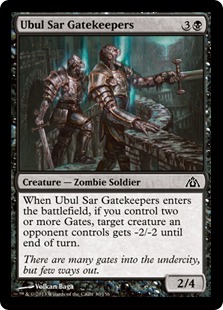
The strategy..?
Before all of our team members had arrived, we did a so-called Hagon Draft (I assume it was invented and/or popularized by Rich Hagon), since it doesn't require a full draft table. Essentially, what you do is make every pick for every player, and try to ignore the fact that you have full information of packs and neighboring players. This is a pretty lengthy exercize, as there are about 200-250 picks in a draft worthy of discussion (at least when a format is new, like now), but it's also pretty useful.
Anyway, in that draft, we ended up with a Gate Control deck that we thought looked really impressive (and really sweet!). Four Gatekeepers, five gates and a Gatecreeper Vine, as well as some decent removal spells and finishers (like Gruul Ragebeast). However, it only went 2-3 in practice matches, to our immense frustration - we really wanted it to do well - while the unexciting-looking Orzhov aggro deck (that even completely failed to get the Gatecrash pack hookup due to the Esper player to its left) went 3-1. After a few real drafts, the terrible-looking two colored decks kept doing well, and I decided to attempt to stick to two colors every time from now on. At the end of the week, I had by far the best win percentage of the group. In the last few drafts, I had drafted Orzhov twice (didn't lose a match with either), Boros once (3-0), Golgari once (2-1). The combined win percentage of two-colored decks was 68%, as shown by this table:
One of the most interesting drafts was the second time I drafted straight Orzhov. This time around, the second pack payoff didn't present itself, and the good Orzhov cards were being picked up by the players to my left. I responded by switching approach to a different kind of Orzhov deck - Orzhov aggro. I picked up Boros Elite, some tricks and cheap fliers, and got two late Shadow Slices. In the last pack, I got some aggressive guys like Dead Reveler, as well as cheap fliers like Concordia Pegasus and a couple of Daggerdrome Imps, which are quite good at wielding Shadow Slice and triggering battalion. The deck didn't have many consensus "good cards" in it, but it was fast and consistent, which was enough to 3-0 the draft.
Some of our team members insisted until the very end that their multicolor monstrosities were actually good, but that there were some other reason than the deck's quality (with other words, variance) for their failure. It might even be true, but numbers don't lie, do they...? Regardless, by the time we got to the first Pro Tour draft, all of us were on the two-color plan. When I got there and talked with people from other teams, it was clear that we weren't the only ones. When I got to the venue on Thursday, the first thing Sweden's Elias Watsfeldt asked me was how many colors I thought one was supposed to be in this format, I immediately showed him two fingers, and he nodded in approval. It obviously doesn't prove that it's true, but I do think it's worth paying attention to when multiple teams arrive at that same conclusion.
Here's how it works:
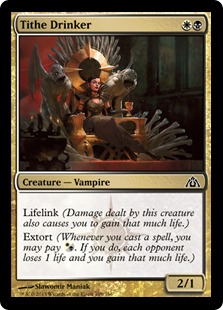
Don't pass this guy if you want
to be Orzhov.
The Gatecrash guild is typically more powerful, but it is also more risky, because it goes against conventional draft wisdom that says that you should care about the signals you're sent, not the ones you send. The reason is that the only time you'll get cards in your guild is in the second booster, and if you've sent your neighbors into your guild, you won't be receiving much good in the second pack. As such, your objective in the first pack is to not pass a single good multicolored card in your guild. If you have passed a Tithe Drinker in a pack where it was among the 4-5 best cards, you will create an Orzhov drafter to your left who will proceed to take all the good Orzhov cards away from you in the second pack, leaving you with a very weak deck. If there are multiple good multicolored cards in the same Gatecrash guild in your first pack, you may want to take something else for that reason.
So you must prioritize taking the multicolored cards whenever you can, because it's really important for signalling purposes. If you're Gruul and get passed Zhur-Taa Druid and Punish the Enemy, it might seem like a tough pick, but it really isn't. Punish the Enemy is a solid card in four different guilds, which ironically makes it a worse pick for us. Taking that Druid not only means you're getting a very strong two-drop that'll fit perfectly in your deck, it'll also remove incentive for the guys to your left to go Gruul. Maybe they'll end up in Boros or Izzet or something instead with that Punish the Enemy. As a quick aside, I think Rubblebelt Maaka is better than Punish the Enemy. It's way cheaper, it's more flexible, and it does exactly what the aggressive decks in this format need to do. You should probably pick it up earlier than you're currently doing.
This is a strategy that'll pay off in spades if it works, as the Gatecrash guilds are really strong (particularly Orzhov and Boros, Dimir less so). But the problem is that you can't really know if your neighbor is on the same plan of cutting a certain Gatecrash guild super hard. If they are, there is very little you can do, and they're going to be the one to reap the rewards, while your deck will probably be a mess.

Seeing this late bodes well for
your third pack.
This is the somewhat safer option, and your strategy is interestingly enough the polar opposite of what it'd be if you wanted a Gatecrash guild. When drafting an RtR guild, you can completely ignore the signals you send, since the second pack won't yield you any guild cards anyway, but focus on reading the signals coming from your right, and try to figure out which RtR guild is open. If you get a fourth pick Carnage Gladiator or a fifth pick Fluxcharger or the like, that's your sign.
This strategy requires a great deal of patience and discipline. It's going to be very tempting to jump into a second/third guild during the Gatecrash pack, but you should resist that temptation, and pick up single colored cards as long as possible (though small splashes are certainly okay, if you have the support). If you read the signals correctly, you should be rewarded in the last pack.
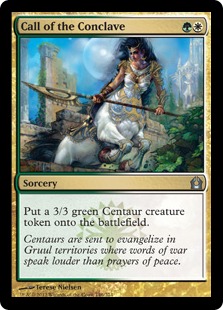
When would you rather cast this
- turn two or turn four?
That's the obvious question - clearly, the multicolored cards are in general much more powerful than the monocolored ones, so it'd make sense to be at least three guilds in order to pick up at least some of these in each pack. The reason is, of course, consistency. You lose more by adding the extra color than immediately apparent:
● You have to spend relatively early picks on fixing, and especially on Guildgates, which are easily the best fixers, but are as such also highly sought after1.
● Even with a reasonable number of manafixers, you'll lose plenty of games to your own mana. Expect to get colorscrewed 2-3 times per draft.
● And even if you draw your fixers in a game, they'll often slow you down and not let you play your two-drops on turn two, your three-drops on turn three, etc. Imagine if you have a hand with Plains, Plains, Simic Cluestone, Call of the Conclave, and some other stuff. Sure, you'll probably be able to play that Call of the Conclave, but it'll be a four-drop, not a two-drop, and therefore a lot less effective.
There are a lot of small edges all the way through the draft, from when you can safely pick that Basilica Guard over an Orzhov Guildgate in pack two, to when you can keep a hand with three basic lands and expect to be able to play your spells, to when you can actually summon Tithe Drinker when it's at its best - turn two. Sure, your deck will be less powerful, but you'll rack up wins while your opponents stare at their unwieldy manabases and play their spells off curve.
1Note that this is especially true at this moment, when most people consider this a three-color format and not a two-color format. If this perception should change, Guildgates and other fixing such as Prophetic Prism and Gatecreeper Vine should also go later in a draft than they do today, reducing the validity of this argument. With other words, if fewer people draft several colors, those decks do become better, as they won't necessarily have to spend quite as many early picks on fixing.
Which colors and guilds are the best?
Our group has had the most success with the white guilds, especially Orzhov and Boros. Orzhov is probably the most powerful guild, with extort being even better than it was in Gatecrash, since the decks tend to be a little bit slower. Tithe Drinker is probably the best common card in Dragon's Maze, and should be picked very early. Here's a table showing the various guilds' performances in our practice drafts. Note that this chart includes three-colored decks as well, meaning that for instance, a Jund deck would influence the numbers of Gruul, Golgari and Rakdos all.
As you can see, Boros and Orzhov had win percentages around the 60% mark, while the other guilds had at best a 50% record. The Rakdos numbers are heavily influenced by poor performances by the various Grixis decks that were drafted.
This table shows the records of each archetype, but it should be noted that at this point the samples are getting rather small:
This table shows how the white guilds were outperforming the rest:
Other notes about Dragon's Maze Limited
- I think that one thing that's worth pointing out about this format is that in the first pack, the uncommons are a lot better than most commons. Several of the split cards are very powerful, as are the guild uncommons like Warleader's Helix, Haunter of Nightveil, Trostani's Summoner, Gruul War Chant and Krasis Incubation. It is worth remembering that getting a fifth pick Punish the Enemy doesn't really necessarily mean much, since many Dragon's Maze packs include three strong uncommons and a bomb rare. Pay attention to the rarity of the cards in your pack, and you may be able to figure out how much of a signal that Punish the Enemy really is.
- While the format is slower than the previous couple of formats, your curve is still really important. Most decks will have few removal spells, but there are many ways to make blocking bad (bloodrush, evasion, detain, etc), so having a good curve is both the way to get ahead and catch up. Prioritize two-drops, and only play a couple of expensive cards. We're playing two colors in order to be able to cast most of our spells on time every game, and for the same reason you should avoid cramming your decks with Maze creatures and the like, even though Abomination and Glider certainly are serviceable. You should not spend early picks on late drops unless they're amazing bombs, as they're rather replaceable and you only want a couple at most anyway.
- Fliers are good, even more so than in most formats. It's not terribly difficult to clog up the ground, and a couple of Wind Drakes really can go the distance in this format. This is partly why I think Azorius is a better guild in this format than it was in triple Return to Ravnica.
- Runner's Bane is decent if you're beating down, and pretty bad if you're controlling. Remember that the aura drops off should the creature's power grow to above 3, so you should look to board it out against many decks.
The first draft was a little bit strange, with green being very underdrafted at the table, but I didn't realize it until a Gruul War Chant, an extremely powerful card and an early pick, came to me eighth, and I promptly shipped it along, as I was solidly in Orzhov already.
| Pro Tour Dragon's Maze - First draft deckMagic OnlineOCTGN2ApprenticeBuy These Cards | ||
|---|---|---|
|
Lands (18) 1 Dimir Guildgate 1 Orzhov Guildgate 1 Transguild Promenade 1 Island 7 Plains 7 Swamp Creatures (12) 1 Hired Torturer 1 Dead Reveler 1 Scion of Vitu-Ghazi 1 Skymark Roc 1 Gutter Skulk 1 Armory Guard 1 Tithe Drinker 1 Basilica Screecher 1 Knight of Obligation 1 Undercity Informer 1 Azorius Arrester 1 Rakdos Drake | Spells (10) 2 Debtor's Pulpit 1 Assassin's Strike 1 Launch Party 1 Stab Wound 1 Far//Away 1 Protect//Serve 1 Azorius Cluestone 1 Swift Justice 1 One Thousand Lashes | Sideboard 1 Zanikev Locust 1 Psychic Strike 1 Purge the Profane |
The splash in this deck is pretty much free, and the only spell I can't cast without blue is Skymark Roc. There is an extra land in there as a concession to the fact that there are two Debtor's Pulpits, which essentially come at the cost of sacrificing a land. The deck looks unexciting, but the consistency is why it's decent. All of my opponents in this draft struggled with their straight up three-colored manabases, which gave me some easy wins. I went 2-1 with this deck, losing to a solid green deck in the final.
The interesting match was round two, when I played against a RUG deck with multiple bombs - Hypersonic Dragon, Ætherling and Gruul Ragebeast. I won the first game due to him being a little short on blue, and had to run out his Ætherling without a blue mana up, which allowed me to enchant it with One Thousand Lashes. He wins the second game with his Ragebeast, and in the third game I put him on the play to increase the already high probability that he'll lose to his own manabase (he was playing three colors and had shown me no fixing so far). That didn't happen, and instead he played a turn four Fluxcharger into a turn five Hypersonic Dragon, but I would still have made the same choice again, and it's something I recommend thinking about. This is a play format most of the time, but some decks can really be punished by being denied the extra card. Anyway, I was pretty sure I was losing that game, but I clawed my way back with One Thousand Lashes and a couple of Debtor's Pulpits, and I eventually win by going aggressive with the Pulpits and finishing off my opponent with Launch Party. One funny interaction I had not thought about before I played this match was how Pulpit actually deals with Ætherling. Of course, a lot of teams had discovered this already and had therefore put Pulpit in the sideboards of their block decks, but I still found it a cool discovery that's even somewhat relevant for Limited.
The second draft did not really go as planned. In this one, I decided to stay open because of the number of different good uncommons and rares I was shipped in the first pack. My P1P1 was Scab-Clan Giant from a weak pack, then I was passed in succession Mirko Vosk, Dusk Drinker, Thrashing Mossdog, Jelenn Sphinx, Krasis Incubation, Jelenn Sphinx. Upon receiving the second Sphinx, I settled for Azorius, since I figured it was wide open. No such thing though, and there were no Azorius cards at all for me in the third pack. As it turned out, my neighbor to my right (Dan Jordan) was Esper, so I had to do something else. I ended up managing to salvage a not horrendous five-color deck, but it was certainly not what I had been looking for.
| Pro Tour Dragon's Maze - Second draft deckMagic OnlineOCTGN2ApprenticeBuy These Cards | |
|---|---|
|
Lands (17) 7 Forest 3 Island 3 Plains 2 Gruul Guildgate 1 Rakdos Guildgate 1 Azorius Guildgate Creatures (18) 2 Gatecreeper Vine 1 Centaur Healer 1 Drakewing Krasis 2 Jelenn Sphinx 1 Risen Sanctuary 1 Mirko Vostk, Dusk Drinker 1 Scab-Clan Giant 1 Thrashing Mossdog 1 Haazda Snare Squad 1 Gyre Sage 1 Slum Reaper 1 Greenside Watcher 1 Frilled Oculus 1 Scab-Clan Charger 1 Frontline Medic 1 Ivy Lane Denizen | Spells (5) 1 Krasis Incubation 1 Vraska the Unseen 1 Selesnya Cluestone 1 Azorius Cluestone 1 Prophetic Prism |
The manabase in this deck is far from terrible, but certainly slows the deck down quite a bit, making each individual card a bit worse than they'd have been in their respective two-colored decks. But for a draft gone wrong, it's not the worst. I went 2-1 in this draft, losing in the final again.
The most interesting situation in this draft was in the very first game, when I had my opponent on two life while I was on 10, and he had a Towering Thunderfist with Way of the Thief on it. I had a tapped 6/4 Drakewing Krasis (due to a scavenged Thrashing Mossdog) and an untapped Jelenn Sphinx, and one untapped land (any color, due to Prophetic Prism). I had a Gate. My opponent tanks hard before finally showing Traitorous Instinct, and I immediately scoop up my cards. After the match (I won 2-1), we have the following conversation:
Him: "You weren't dead to that Traitorous Instinct, though"
Me: "I was"
Him: "I take your Krasis, attack with my 6/6 and the 8/4. You block with Sphinx and take 9"
Me: "If you take the Jelenn Sphinx, you attack with a 3/5 and a 7/7 (due to the Sphinx' ability), totalling exactly ten damage"
Him: "Aaah. Yeah, I didn't do the math"
Lesson learned: don't pick up your permanents until your opponent actually chooses a target! (Or don't scoop prematurely in general)
To conclude, I think the drafts went pretty well, and we felt we had a pretty good understanding of the format, although the format is so complex that it'll take a while still before one can be too certain. One thing I was surprised by was how many of my opponents were playing straight up three colors, and by that I mean that all of them were. In the first draft, I felt it gave me the opportunity to get on the board and beat them down before they could do much, and in the second draft, I felt it gave me the time to durdle around with my various colors and guildgates without getting punished. Time will tell if I'm right in my assessments, but for now, this is my story and I'm sticking to it.
Thanks for reading!
—Sene
Click here if you want to read and post comments on the article!

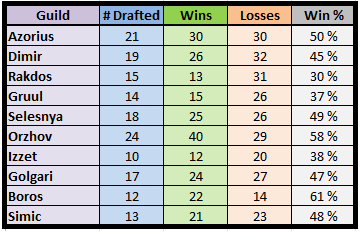
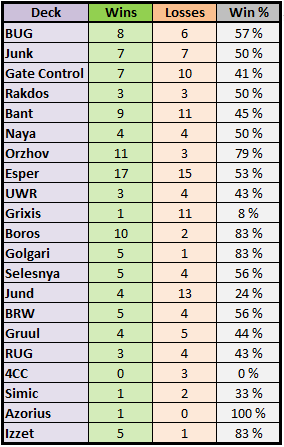

Comments